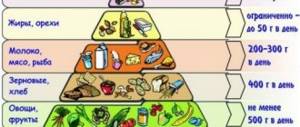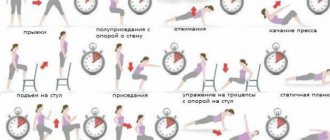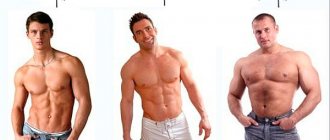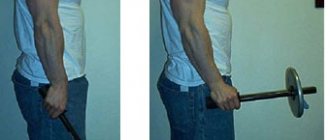When a person is born, nature endows him with certain characteristics. These include: body types, muscle to fat ratio, skeletal structure. The formation of the physique depends on these features. Knowledge of the principles of body constitution helps to understand why, with equal physical stress on the skeleton and muscles, a similar diet, different individuals have different figures. A wiry body or an obese body reacts differently to stress and food consumed.
Young men, guys striving for an athletic figure, should have a complete understanding of their physique. It is divided into three types:
- ectomorphic;
- mesomorphic;
- endomorphic.
To develop a training complex to strengthen the athlete’s skeleton and muscles, it is important to determine the body type.
Content
- 1 Body measurements
- 2 Body proportions 2.1 Indices and types of body proportions
- 2.2 Body proportions and human age
- 2.3 Body proportions and gender differences
- 2.4 Body proportions and constitutional type
- 2.5 Group differences in body proportions
- 3.1 Kretschmer's human typology
Main characteristics of an ectomorph
The main problem of an ectomorph is a constant lack of mass. There are also advantages here - you don’t have to limit yourself to eating high-calorie foods. Outwardly, the average representative of this type is a slender, thin man. The rapidity of metabolic processes is the main reason for the absence of extra pounds. To get a strong physique, you need to put in maximum effort. By nature, ectomorphs are characterized by a skinny body and weak muscles. After gaining muscle mass, the ratio of body proportions is long slender legs, narrow waist. The amount of adipose tissue is at a minimum level.
Achieving an athletic physique is only possible with a protein diet. In terms of percentage, proteins in the daily diet should provide 30% of calories, carbohydrates - 50%, fats - approximately 20%. To gain weight, you cannot burn all the calories you receive. It is recommended to eat 5-6 times a day. Due to the fact that success in gaining weight largely depends on proper nutrition, you need to adhere to the following features:
- include more than half of the volume of vegetables and complex carbohydrates in food;
- Eliminate fast carbohydrates completely from the diet;
- protein is consumed at 2-2.5 g per kg of weight;
- Consume dairy products with 1% fat content.
The sports training regime should be limited to no more than 3 times a week. The load is close to maximum values, the duration is 45 minutes. It is recommended to exercise using a split system. Each session should work on a specific muscle group. The following scheme is proposed:
- Day 1 – biceps, chest;
- Day 2 – legs, shoulders;
- Day 3 – back, triceps.
The rule for beginners is to increase complexity not at the expense of duration, you need to increase loads, weights, and perform more strength exercises. The formation of muscle mass is slow, training must be alternated with rest. If the muscles do not recover after 1 day of rest, you need to extend the rest to 2 days. Excessive training threatens to reduce weight gain.
It is better to change the types of activities monthly. You should do strength training for 3-6 weeks. Use only basic exercises (up to 2 movements per muscle group). Over the next 6 weeks, try to gain muscle mass. The classes include 2 basic and 2 isolation exercises. We must not forget about rest - a week's rest is provided between training series.
The next step is to work with your own body weight:
- push ups;
- pull-ups;
- stretching exercises.
You can actively play basketball and football. Outdoor training will be especially effective in the summer. Aerobic exercises are useful - 2-3 times a week for 30 minutes (running, race walking, swimming, exercise equipment).
Body measurements[ | ]
Among the body sizes there are total
(from lat. totalis - whole, whole, complete) and
partial
(from lat. pars - part).
Total
(general) body dimensions are the main indicators of human physical development.
These include body length and weight, as well as chest girth. Partial
(partial) body sizes are components of the total size and characterize the size of individual parts of the body. Body dimensions are determined by anthropometric examinations.
Most anthropometric indicators have significant individual variations. The total dimensions of the body depend on its length and mass, and the circumference of the chest. The proportions of the body are determined by the ratio of the sizes of the torso, limbs and their segments. Body size (along with other parameters characterizing physical development) are important parameters for sports selection and a sports career. For example, to achieve high athletic results in basketball, tall height and long limbs are of great importance. At the same time, it is not uncommon for those athletes whose somatotype differs from the best for a given sport to achieve great success. In such cases, the influence of many factors is felt, and primarily such as the level of physical, technical, tactical and volitional training of athletes.
Melatonin somatic type
Melatonin is formed in the absence of daylight from serotonin. You could say this is its antipode. Serotonin increases joy, while melatonin, on the contrary, causes sadness and depression. This type is also affected by vasopressin and aldosterone. Due to the latest hormones, the melatonin type is prone to fluid retention and swelling.
Somatypology considers the melatonin type of people to be fickle. They are sometimes quiet and shy, sometimes timid, but when they set a goal, they go no matter what.
In general, their main problem is a negative outlook on life, a tendency towards sadness and depression.
They have a very good memory. They do not want to work in a crowded environment; they would do better in a quiet place where they need to work with large amounts of information. You will be a good specialist, analyst, designer. They can develop both in art and in analytical abilities.
Very sensitive natures, really capable of empathy. They work well in caring for sick people, children, and cerebral palsy.
There are 2 types of melatonin people. What they have in common is a tendency to pale, a tan is easily acquired and goes away just as easily.
The first type is prone to obesity, and fat deposits are accumulated in the lower part of the body. The body contour may not be clear. Prone to obesity.
The second type, on the contrary, is thin, compensated. He has a developed thyroid gland, so he is not overweight.
| Positive | Negative |
| Developed intuition | Tendency to feel sad and worried about anything |
| Attentiveness | Passivity |
| The ability to notice important little things | Diffidence |
| Persistence in achieving goals | Slowness |
| Will to live | Lack of composure |
| Ability to get up after falls | Stubbornness |
People with melatonin type need to develop optimism. It’s difficult to do this just like that, on your own. It is much more effective to find positive people and communicate with them. At night, despite the desire to daydream, it is much better for them to go to bed.
Body proportions[ | ]
With the same body length, the sizes of its individual parts may be different for different individuals. These differences are expressed both in absolute sizes and in relative values. Body proportions mean the ratio of the sizes of individual parts of the body (torso, limbs and their segments). Typically, the sizes of individual body parts are considered in relation to body length or expressed as a percentage of body length or body length. To characterize body proportions, the relative values of leg length and shoulder width are of greatest importance.
Indices and types of body proportions[ | ]
Since the proportions of the body indicate the ratio of the sizes of its various parts, then, naturally, for their characteristics, it is not the absolute, but the relative sizes of the torso, limbs, etc. that matter. The oldest but most common method for establishing the ratio of sizes is the index method, which consists is that one size (smaller) is determined as a percentage of another (larger) size. The most common method of characterizing body proportions is to calculate the ratio of the length of the limbs and width of the shoulders to the total length of the body. Based on the ratios of these sizes, three main types of body proportions are usually distinguished: 1) brachymorphic, which is characterized by a wide body and short limbs, 2) dolichomorphic, characterized by inverse relationships (narrow body and long limbs) in 3) mesomorphic, occupying an intermediate position between brachy- and dolichomorphic types. The differences between the named types are usually expressed using a system of indexes; for example, as a percentage of body length, the width of the shoulders, the width of the pelvis, the length of the torso, and the length of the legs are determined. These indices can be used as a means of directly expressing the form and are quite suitable for this purpose[1][2].
Body proportions and human age[ | ]
Age-related changes in body proportions.
KM - middle line. The numbers on the right show the ratio of body parts in children and adults, the numbers below show age. Age-related differences in body proportions are well known: a child differs from an adult in having relatively short legs, a long body, and a large head (Fig.). To characterize age-related changes in body proportions, one can express the sizes in children as fractions of the values of these sizes in adults, taking them as a unit. Below are data on age-related changes in body proportions in boys (according to Bunak)[3]:
| Dimensions | Newborns | 1 year | 4 years | 7 years | 13 years | 17 years | 20 years |
| Leg length | 0,24 | 0,36 | 0,56 | 0,68 | 0,85 | 0,98 | 1,00 |
| Arm length | 0,32 | 0,44 | 0,54 | 0,67 | 0,81 | 0,97 | 1,00 |
| Body length | 0,36 | 0,46 | 0,6 | 0,68 | 0,82 | 0,92 | 1,00 |
| Shoulder width | 0,32 | 0,44 | 0,58 | 0,68 | 0,83 | 0,93 | 1,00 |
| Pelvic width | 0,28 | 0,44 | 0,6 | 0,68 | 0,83 | 0,93 | 1,00 |
Table 2. Body sizes in men and women with the same initial size (according to Bunak)
Body proportions and gender differences[ | ]
Sex differences are partly due to differences in body length between men and women, but mainly they are a specific manifestation of sexual dimorphism. Women differ from men in having a wider pelvis and a smaller shoulder width (relative to body length).
Arm length and leg length as a percentage of body length are approximately the same in both sexes.
If we consider the body proportions of men who do not differ on average in height from women, then the results will be different, namely: such men, on average, will certainly be longer-legged (by index) than other men. This long-leggedness is a consequence of the fact that the correlation between leg length and body length is small and therefore among the small-bodied men selected there will be subjects with both short and long legs. Studies have shown that women differ in the relative length of their legs from both short men and men with a small frame. The woman is longer-legged than the first, and shorter-legged than the second. Similar results are obtained when women’s sizes are reduced to the body length and body length of men (Table 2). In all calculations, men have relatively narrower pelvises and wider shoulders than women.
Body proportions and constitutional type[ | ]
The harmony of body proportions is one of the criteria when assessing a person’s health status. If there is a disproportion in the structure of the body, one can think about a violation of growth processes and the causes that determined it (endocrine, chromosomal, etc.). Based on the calculation of body proportions in anatomy, three main types of human physique are distinguished: mesomorphic, brachymorphic, dolichomorphic. The mesomorphic body type (normosthenics) includes people whose anatomical features are close to the average normal parameters (taking into account age, gender, etc.). People with a brachymorphic body type (hypersthenics) have predominantly transverse dimensions, well-developed muscles, and are not very tall. The heart is positioned transversely due to the high-standing diaphragm. In brachymorphs, the lungs are shorter and wider, the loops of the small intestine are located predominantly horizontally. People with a dolichomorphic body type (asthenics) are distinguished by a predominance of longitudinal dimensions, have relatively longer limbs, poorly developed muscles and a thin layer of subcutaneous fat, and narrow bones. Their diaphragm is located lower, so the lungs are longer, and the heart is located almost vertically. In table Figure 3 shows the relative sizes of body parts in people of different body types.
Table 3. Body proportions (according to P. N. Bashkirov [4]):
| Body type | Dimensions of body parts relative to body length, % | ||||
| Length | Width | ||||
| torso | legs | hands | shoulders | pelvis | |
| Dolichomorphic (asthenic) | 29,5 | 54,0 | 46,5 | 21,5 | 16,0 |
| Mesomorphic (normosthenic) | 31,0 | 52,0 | 44,5 | 23,0 | 16,5 |
| Brachymorphic (hypersthenic) | 33,5 | 50,0 | 42,5 | 24,5 | 17,5 |
Group differences in body proportions[ | ]
Determining your body type
By the wrist
To determine your type of build, it is necessary to measure the girth of the wrist, since it is by the thickness of the bones that one can determine the somatotype, and the wrist remains unchanged when muscle or fat mass changes.
| Body type | Men's wrist circumference | Women's wrist circumference |
| Ectomorphic | Up to 17 cm | Up to 15 cm |
| Mesomorphic | 17-20 cm | 15-17 cm |
| Endomorphic | More than 20 cm | More than 17 cm |
Somatotyping[ | ]
Kretschmer's human typology[ | ]
The specificity of metabolic processes and endocrine reactions constitutes the essence of the functional constitution. The constitution in a broad sense (including genetic, morphological and functional) is of interest because it is considered responsible for the unique reactivity of the organism. The unequal susceptibility of people of different constitutional types to the action of external and internal factors is considered to be proven. Currently, there are more than a hundred classifications of the human constitution, based on various characteristics. Therefore, there are constitutional schemes based on morphological, physiological, embryological, histological, neuropsychic and other criteria. Attempts to classify a person by body structure, behavioral characteristics, or predisposition to certain diseases go back to ancient times. In the 4th century BC. e. The ancient Greek physician Hippocrates was the first to connect the physique of people with their predisposition to certain diseases. Based on empirical comparisons, he showed that short, dense people are prone to apoplexy, while tall and thin people are prone to tuberculosis. However, Hippocrates did not create any classification distinguishing people by type of body structure, since his main interest lay in the study of human temperament. Modern psychology still uses Hippocrates' typology, dividing people into choleric, sanguine, phlegmatic and melancholic. The human typology of the German psychopathologist E. Kretschmer (1888-1964), who was convinced that people with a certain body type have certain mental characteristics, deserves attention. He developed the following body type typology:
- Asthenic - (from the Greek - weak) is characterized by weak growth “in thickness” with greater growth “in length”; he is thin, with thin pale skin, narrow shoulders, and a long and flat chest. He has a fragile build and is tall; seems even higher than it really is[5]; he has thin arms, long lower limbs, an elongated face, a long thin nose[6][7]. In pronounced asthenics, there is also a discrepancy between an elongated nose and underdevelopment of the lower jaw[5]. Asthenic women resemble asthenic men, but they can be not only thin, but also short. Pronounced asthenics age prematurely[5].
- Picnic - (from the Greek - thick, dense) of medium or small height, with rich fatty tissue, a bloated body, a round head on a short neck, with a small wide face. Shows a tendency towards obesity.
- Athletic - (from the Greek - wrestling, fight) has good muscles, a strong physique, average height, wide bones, a wide shoulder girdle and narrow hips, convex facial bones.
In addition to the named types, E. Kretschmer also identified a dysplastic type, characterized by a shapeless structure and various deformations of the physique.
Ecto-, meso- and endomorphy[ | ]
Stages of human intrauterine development.
Formation of three germ layers: ectoderm, mesoderm and endoderm In the West, there are three main body types: ectomorphic, mesomorphic and endomorphic. They received these names from the names of the three germ layers: the outer one - the ectoderm, from which the nervous system, integumentary tissues (skin) and glands are formed; mesoderm, from which the musculoskeletal and cardiovascular systems are formed; internal - endoderm, from which the digestive tract is formed. It is known that by the end of the third week of development, the human embryo has the appearance of a three-layer plate, or a three-layer shield. In the area of the outer germ layer, the neural tube is visible, and deeper - the dorsal chord, that is, the axial organs of the human embryo appear. The body of the embryo turns from a flat shield into a three-dimensional one; the ectoderm covers the body of the embryo on all sides. From the ectoderm, the nervous system, the epidermis of the skin and its derivatives, the epithelial lining of the oral cavity, anal rectum, and vagina are subsequently formed. The mesoderm gives rise to internal organs (except for derivatives of the endoderm), the cardiovascular system, organs of the musculoskeletal system (bones, joints, muscles), and the skin itself. The endoderm, once inside the body of the human embryo, curls up into a tube and forms the embryonic rudiment of the future intestine. The narrow opening connecting the embryonic intestine with the yolk sac later turns into the umbilical ring. The epithelium and all glands of the digestive system and respiratory tract are formed from the endoderm.
Sheldon's somatotyping system[ | ]
Sheldon's somatyping system.
Pure endomorph (7-1-1), Pure mesomorph (1-7-1), Pure ectomorph (1-1-7) The scientific basis of somatotyping was developed by Harvard University professor William Sheldon (1898-1977). Following this system, all people are divided according to morphological characteristics into endomorphs, mesomorphs and ectomorphs. The quantitative assessment of each of these three components is determined for each individual so that “1” represents the absolute minimum severity of this component, and “7” the absolute maximum. From a historical point of view, a somatotype is a characteristic of the physique, defined according to the system of W. Sheldon, who in 1940 was the first to suggest that there are not discrete types of physique, but continuously distributed “components” of the physique, the totality of which characterizes the physique. Sheldon identified three such components - endomorphic, mesomorphic and ectomorphic, each of which is assessed visually by a qualified specialist using a point system (from 1 to 7 with even intervals between points). The totality of scores for three components - a triple of numbers A-B-C - is called a person’s somatotype. To facilitate assessment, Sheldon published an atlas of somatotypes in 1954; according to his method, it was not necessary to take any measurements - it was enough to have three photographs of a person in the nude: from the front, side and back, plus the experience of visual assessment. The components of the somatotype are most clearly visible when describing extreme manifestations:
- Pure endomorph (Endo - Heavy, Morph - Shape) (7-1-1) is characterized by spherical shapes. Such an individual has a round head, a large belly, weak, flabby arms and legs, with a lot of fat on the shoulders and hips, but thin wrists and ankles. This person is, to a greater extent, accompanied by excess fat deposition.
Drawings from Sheldon's atlas. Pure endomorph (7-1-1), Pure mesomorph (1-7-1), Pure ectomorph (1-1-7)
- Pure mesomorph (Meso - Average, Morph - Form) (1-7-1) is a person whose body is comparable to a rock. He has a massive cubic head, broad shoulders and chest, and muscular arms and legs. The amount of subcutaneous fat is minimal, the profile dimensions are small.
- Pure ectomorph (Ecto - Light, Morph - Form) (1-1-7) - this person has a thin, elongated face, a chin set back, a high forehead, a narrow chest and stomach, a narrow heart, thin and long arms and legs. The subcutaneous fat layer is almost absent, the muscles are not developed. A pure ectomorph does not suffer from obesity.
Most people do not belong to the extreme body types (endomorph, mesomorph, ectomorph), all three components are expressed to one degree or another in their physique, and the most common somatotypes will be 3-4-4, 4-3-3, 3-5- 2. In addition, individual parts of the body of one person can clearly belong to different somatotypes - such a discrepancy is called dysplasia, but its accounting remained a weak point of the Sheldon system.
Sheldon viewed a person's somatotype as unchanged throughout life - the appearance and size of the body change, but not the somatotype. For example, various diseases, poor nutrition or muscle hypertrophy associated with increased physical activity change only the outline of the body, but not the somatotype itself.
Of great interest are the studies of Sheldon and his students, who were devoted to studying changes in a person’s body weight (height-weight index) throughout his life, depending on his somatotype. A huge number of anthropological measurements were taken over decades, and the results were tabulated. Based on these tables, it is possible to predict the weight of a male or female individual in various life periods, depending on his height and somatotype.
Forecasting physical development[ | ]
For example, in a study of a group of male students involved in sports of approximately the same age (from 18 to 21 years old), their height, weight and somatotypic data were determined.
Prediction of maximum weight depending on somatotype (according to Sheldon). Explanation in the text)
Student A. Has a somatotype of 5-2-2 and a weight of 72 kg. With a height of 166 cm, this is a predominant endomorph. If we, based on the data from Sheldon’s tables, construct a graph of the dependence of the hypothetical body weight for a given somatotype at different periods of his life, we will see that his real weight exceeds the calculated one and will probably increase with age to 84 kg by the age of 60. Student B. is predominantly a mesomorph and his predicted weight will probably be 83 kg in the older age group. It’s a different matter, student V., with a height of 185 cm, he weighs 67 kg. This is a normal weight for his constitutional type and we see that with age his weight will change little. Thus, when determining the somatotype, it is necessary to take into account age, the presence or absence of pathological processes and the degree of physical activity, that is, it is necessary to have a certain experience that allows you to see a “skinny endomorph” or a “fat mesomorph”. In the practice of somatotyping, it is believed that for the final assessment one should take the somatotype that develops by the age of 20-25 with normal nutrition. Sheldon's concept of unchanging somatotypes was convenient both for theoretical anthropometry and for studying natural body types. However, the rapid development of bodybuilding in the 60s led to the appearance of such muscularly developed bodies, the parameters of which did not fit into any framework. The training system developed in bodybuilding and the emergence of special food products (proteins, energy drinks, free amino acids) actually made it possible to change the somatotype and maintain it in an altered form for as long as desired.
Somatosection of Heath-Carter[ | ]
In 1968, American physiologists B. Heath and L. Carter refined the Sheldon system, eliminating the upper limit for evaluation scores, presenting formulas for the numerical rather than visual determination of somatotype components and formulas for calculating the XY coordinates of the resulting point on a plane with three axes. Thus, the calculation of somatotype components based on correctly taken measurements made it possible to obtain a completely objective and adequately changing assessment of the physique in the form of a single visual point on the plane. English anthropologists widely use Parnell's scheme (Parnell, 1958), based on the use of the table given in the work of Heath [8] [9] (1968). It takes into account three sets of measurement characteristics for representatives of different age groups: height-weight ratios, bone diameters and girth dimensions, as well as skin-fat folds. The result is a somatotype score. Despite the fact that Parnell criticized a similar scheme, mainly for the incorrectness of the photography technique and subjectivity in assessing the development of body composition components and somatotype scores, this method is, of course, based on Sheldon’s approach. In particular, an arbitrary seven-point scale is retained; the distribution intervals of the fat component scale are given in accordance with the Sheldon average values. Graphically, a somatoslice is expressed as a point on a plane with three coordinate axes located at an angle of 120° to each other.
Somatoslice Heath-Carter. Explanation in the text
The axes are endomorphy (“fat”—left-down), mesomorphy (“muscles”—up), and ectomorphy (“bones”—right-down). For example, more fit, slender people are “located” on the somatoslice plane in the region of zero, somewhat to the right of the origin, fashion models - even more to the right; bodybuilders are located along the mesomorphy axis in the upper part of the plane with a Y value of more than ten, and excess weight pushes the point to the left of zero. As muscle mass and the amount of fat in the body changes, the somatoslice will change, and in comparison with the points of previous measurements, you will be able to observe the drift of the current point, showing the direction of changes occurring in your body. The advantage of the Heath-Carter scheme is that it is recommended by the authors for people of both sexes, all nationalities and races, ranging in age from 2 to 70 years.
Modern methods of somatotyping[ | ]
Today, there are numerous modifications of somatotyping, for example by V. P. Chtetsov or M. V. Chernorutsky, which is traditionally used in medical practice to designate constitutional types [10]. With this scheme, the following three types are distinguished:
- Normosthenic type, characterized by proportional body size and harmonious development of the musculoskeletal system;
- The asthenic type, which is distinguished by a slender body, weak development of the muscular system, a predominance (compared to the normosthenic) of the longitudinal dimensions of the body and the size of the chest over the size of the abdomen; the length of the limbs is above the length of the body;
- The hypersthenic type, which differs from the normosthenic type by good fatness, a long body and short limbs, a relative predominance of the transverse dimensions of the body, the size of the abdomen over the size of the chest.
There are three main body types (or somatotypes):
- mesomorphic,
- brachymorphic or its opposite dolichomorphic
.
Notes[ | ]
- Roginsky Ya. Ya., Levin M. G.
Anthropology. Textbook for university students. — 3rd ed. - M., Higher School, 1978, 528 p. - Bunak V.V.
Anthropometry. Practical course. - M., 1941. - Bunak V.V.
Dimensions and shapes of the human spine and their changes during the period of growth. “Uch. zap. Moscow State University", vol. 34. Anthropology. 1940.) - Bashkirov P.N.
The doctrine of physical development of man. - M., 1962. - ↑ 1 2 3 Arkin E. A.
Personality and environment in modern biology. - State Publishing House, 1927. - Golovin S. Yu.
Dictionary of a practical psychologist. - M.: AST, Harvest, 1998. - Large psychological dictionary. Ed. B. G. Meshcheryakova, acad. V. P. Zinchenko. - M.: Prime-EVROZNAK, 2003.
- Heath B.H.
Modern methods of somatotyping. Part 1. Question Anthropol., 1968, issue. 29. 20-40. - Heath B. H., Carter D. L.
Modern methods of somatotyping. Part 2 Question Anthropol., 1969, issue. 33. 60-79. - Nikityuk B. A., Chtetsov V. P.
Human morphology. - M., Moscow State University Publishing House, 1983. 320 p.










